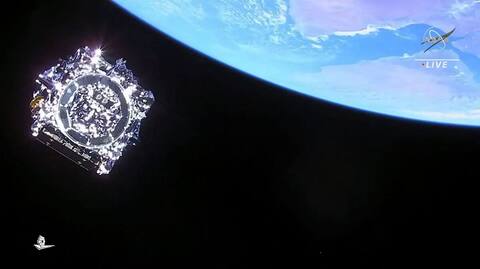The James Webb Space Telescope on Saturday successfully completed the final stage of its deployment with its main mirror and is now in its final configuration to be able to begin, in just over five months, the exploration of the universe.
• Read also: A potentially dangerous asteroid will pass near Earth
• Read also: The James Webb Telescope’s heat shield has been deployed, a critical step in the mission
• Read also: 2022 will be more than ever the year of space
“I was very impressed,” said Thomas Zurbuchen, NASA’s director of science missions, from the Control Center in Baltimore, on the east coast of the United States. “We have a telescope in orbit!”
The telescope’s iconic main mirror is about 6.5 meters in diameter, so it was just too big to fit a rocket as it was when it took off two weeks ago. So it is necessary to bend its sides back.
The first of these two suites was deployed on Friday, and the second opened Saturday morning as planned. The space agency teams then spent several hours locking it in place, in order to secure it permanently.
Dozens of engineers, who have rotated 24 hours at the Space Telescope Science Institute since launch, exploded with glee once this latest move was confirmed, according to images streamed live online.
Then NASA Administrator Bill Nelson spoke via the video link: “What a great day!” He said, obviously very impressed. NASA is a place where the impossible becomes possible.
Deploying such a telescope into space, not just of its mirrors, but also of its heat shield earlier this week, was a risky procedure that had never been tried in the past.
Astronomers around the world, who will be using this flying observatory, can breathe a sigh of relief now that the mission now appears to be on track to success.
Before the telescope can start working, it still has to reach its final orbit at 1.5 million km from Earth (it is already more than 1 million km away from us).
Each hexagonal piece that makes up this massive primary mirror, covered in gold in order to better reflect light, must also be carefully adjusted. Scientific instruments must continue to cool and be calibrated very precisely.
The most powerful space observatory ever built, James Webb should make it possible to observe the first galaxies, which formed only about 200 million years after the Big Bang.
It also needs to take a major step forward in the exploration of exoplanets orbiting stars other than the Sun. He will examine their atmosphere for conditions conducive to the emergence of life.
Close observations are also planned, in our solar system, of Mars or of Europe, the moon of Jupiter.
To detect the faint glow from the far reaches of the universe, James Webb needed a main mirror larger than any mirror sent into orbit so far.
The secondary mirror, which is much smaller and sits at the end of a tripod in front of the main mirror, was successfully deployed on Wednesday. It is used to focus light from the primary mirror, before directing it to a third mirror and the four scientific instruments.
On Tuesday, the expedition reached a major milestone with an even tougher spread, the heat shield.
Made of five layers each the size of a tennis court, but thin as hair, this lens cap protects scientific instruments from the heat of our star.
These layers were carefully opened and stretched one by one. The temperature of the face closest to the Sun can reach 125 ° C, and the farthest – -235 ° C.
The great novelty of this telescope is that it will only operate in the near and mid-infrared (wavelengths invisible to the naked eye), so its instruments can only work in complete darkness and at extremely low temperatures.
James Webb, who is worth about $10 billion, is expected to be in business for at least 5 years, possibly up to 10 years.
to see also

“Wannabe internet buff. Future teen idol. Hardcore zombie guru. Gamer. Avid creator. Entrepreneur. Bacon ninja.”






